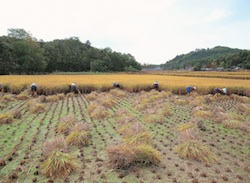
This week I read a book about the ongoing discussions regarding the causes of the food crisis. It should come as no surprise that several of the main reasons the globe is in the midst of a food crisis, according to a The Food Wars author Walden Bello, are commodity speculation, biofuels, increased demand for food in Asia brought on by prosperity, and most influential, the massive ag policy reorientation known as structural adjustment.
“More central as root causes have been structural adjustment, free trade, and policies extracting surplus from agriculture for industrialization, all of which have destroyed or eroded the agricultural sector of many countries. No one factor can be pinpointed as the cause of the global food crisis. It is theconfluence of these conditions that has made the contemporary food price crisis so threatening and difficult to solve,” writes Bello.
One area of focus in The Food Wars, is how US and EU agriculture and agrofuels policies are hurting those very people they are indirectly supposed to be helping. At one point in the book, Bello describes the “capitalism versus the peasant” and details the move to corporate farming – even in the U.S. He cites a statistic about US government subsidies for agriculture, “currently, 38 percent of producers who provide 92 percent of US food receive 87 percent of all farm program payments.”
He then proceeds to explain how the family farm manages to persist among the growing number of corporate farms.
 From there, Bello outlines how many corporate players favor the World Trade Organization’s efforts (WTO) to phase out farm programs that subsidize farmers and allow the dumping of US grain abroad. He then notes that, “the United States has steadfastly refused to significantly reduce, much less dismantle, its farm-support programs, which transfer some $40 billion a year to the agricultural sector from consumers, firms and taxpayers.” He says that this stance ultimately equates to free trade for the world and protectionism for the US.
From there, Bello outlines how many corporate players favor the World Trade Organization’s efforts (WTO) to phase out farm programs that subsidize farmers and allow the dumping of US grain abroad. He then notes that, “the United States has steadfastly refused to significantly reduce, much less dismantle, its farm-support programs, which transfer some $40 billion a year to the agricultural sector from consumers, firms and taxpayers.” He says that this stance ultimately equates to free trade for the world and protectionism for the US.
Obviously, Bello explains the above in great detail in the book but ultimately, he segues into the idea that as we enter the world of deglobalization, there may be an opportunity for peasant and small-farmer based agriculture serving local and regional markets to play a starring role in how the production of food is organized and orchestrated.
Bello does a good overall job of trying to address all the factors that contribute to the rise and fall of food prices. In his conclusion, he offers some ways to help people take control of their food security and points again to small farmers or peasant-based farming as a good model to develop local or regional sustainable alternative economies.

 Photo: Bryan Langfeldt/Iowa State Daily | Posted: Wednesday, September 15, 2010 11:14 pm
Photo: Bryan Langfeldt/Iowa State Daily | Posted: Wednesday, September 15, 2010 11:14 pm
 By Jim Nowlan
By Jim Nowlan The biochar making process is called pyrolysis and this offers a sustainable and effective means of producing energy from biomass and eventually, confiscating the carbon from the atmosphere in form called biochar. Slow pyrolysis and fast pyrolysis are two methods of making biochar.
The biochar making process is called pyrolysis and this offers a sustainable and effective means of producing energy from biomass and eventually, confiscating the carbon from the atmosphere in form called biochar. Slow pyrolysis and fast pyrolysis are two methods of making biochar.



